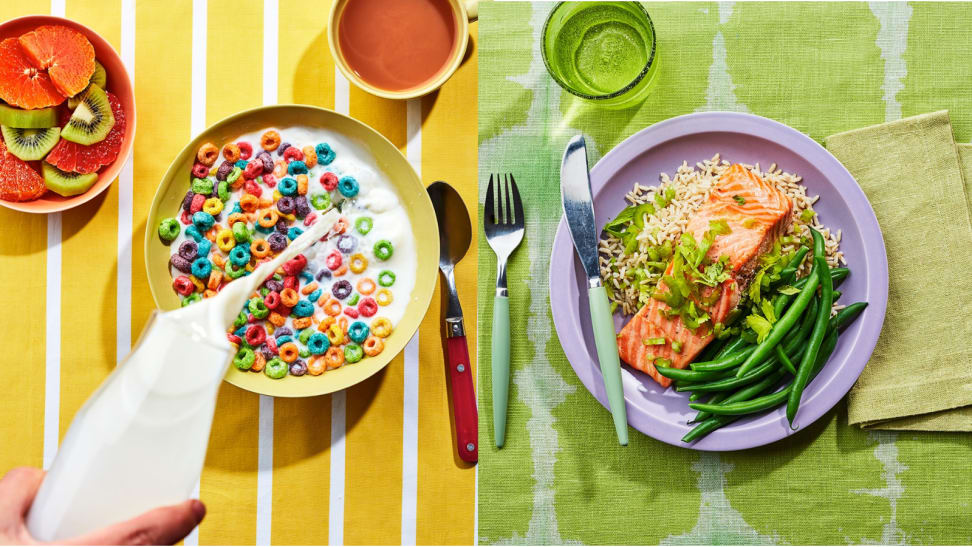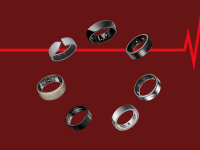Here's everything you can eat on the Noom diet
Yes, you can still have tasty treats!
 Credit:
Noom
Credit:
Noom
Products are chosen independently by our editors. Purchases made through our links may earn us a commission.
Noom is a weight-loss app that takes a “new” approach. It claims to be an easy and fun-to-use app that “provides intelligent nutrition and exercise coaching.” Like many weight-loss programs, you begin with a survey of your current lifestyle and habits—your eating style, stress levels, sleep patterns, activities, etc.
Like other health-focused apps, Noom uses a system that separates "good" and "bad" foods by assigning colors to different edible treats. Each color signifies how much or how little you should eat to stay on track toward your goals. Here's what you need to know.
What is Noom?
One of Noom’s main messages is that the program is based on psychology, so not only are you becoming healthier, you’re building habits that will support you for the rest of your life. As a quick note, I think it’s helpful to imagine you’re adjusting habits to better suit your best self rather than quitting your current lifestyle and building an entirely new one from the ground up. The Noom diet is comprised of evidence-based information, trained cognitive behavior coaches, simple tracking tools, and a user-friendly interface.
What is the Noom diet?

Noom's food database is extensive, so you can research your favorite snacks and recipes.
The Noom diet is a psychology-based program that operates with the core belief of balance. In terms of food, the diet breaks items into three categories: green, yellow, and orange. The green foods are the best, yellow foods are slightly less nutritious, and orange foods are the most calorie-dense. Ideally, your diet is comprised of mostly green foods, some yellow foods, and a limited amount of orange foods.
As we’ve noticed, these categories are more of a framework for thinking about how you eat rather than strict guidelines. “If you go over your Orange food allotment for the day but stay within your calorie range—or even exceed your daily calorie count in total—there are no repercussions beyond seeing the bar chart exceed your target ceiling.”
Noom reminds users that the orange foods aren’t excluded in any way. Instead the color system doubles as a portion guide. You can absolutely eat dessert, especially when the rest of your meals throughout the day contained mainly green and yellow foods. If you’re curious about what you can eat on the diet, we compiled a list of recipes to help you get started.
Green foods with Noom

Green foods include almost all fruits and veggies.
The items on Noom’s list of green foods have low-calorie density and are foods that will help you feel full on fewer calories. Most of the foods on the green list also have many nutrients, but there are more than fruits and veggies, though all fruits and veggies are in the green category. The list also includes whole-grain bread, rolled oats, tofu, quinoa, shrimp, salsa, unsweetened milk alternatives, white fish, Greek (non-fat) yogurt, egg whites, and plenty of other options.
The diet is similar to a traffic light, so the green foods are good. They’re actually so good Noom doesn’t give you a calorie limit for the green foods. Noom even says, “The more Green the better!” You can make entire meals from only foods listed on the Green list: salads, mixed grain bowls, and tacos!
Yellow foods with Noom

Many well-rounded meals combine nutritious green foods and protein-rich yellow foods.
With the Noom diet, the foods in the yellow category have more calories or have fewer healthy nutrients per serving than green foods. These types of food can still be incorporated into your routine, but not as frequently as green foods. A handful of yellow foods are lean meat and starches like turkey breast, grilled chicken, tuna, salmon, and lean beef. However, there are also vegetarian and vegan-friendly protein sources like eggs, black beans, and chickpeas (my favorite!). The yellow category also contains a few somewhat random items like greek yogurt, avocado, and whole-grain tortillas. Other yellow foods are popcorn, low-sodium canned soups, and instant potatoes!
Orange foods with Noom

Red foods don't need to be "guilty pleasures"—they're just food!
Orange foods, as you may already guess, are the most calorie-dense or have the least healthy nutrients. Noom suggests you limit these foods in your diet. The orange category contains oils (olive oil, avocado oil, coconut oil) because of their fat content, seeds (chia seeds, flaxseeds, sunflower seeds, etc), nuts and nut butters (almonds, walnuts, cashews, peanut butter, coconut butter etc), dessert dishes like pie, cake, and cookies, and red meats. Orange foods also include frozen entrees, jerky, dried fruits, crackers, bagels, and protein powders.
As someone with a sweet tooth and a steady supply of ice cream and cookies, I’d probably meet my allotment of orange foods early in the day/week. If you’re anything like me, this article on healthy ways to reduce your sweet tooth may come in handy!
What about drinks?
We all know water is great for us, and a lot of the foods in the green category have high water content. But what about other drinks like coffee, tea, beer, wine, and soda? Since moderation and the actual drink contents (aka sugar) can vary, drinks are typically in the yellow and orange groups. For example, fruit juice can be delicious and nutritious but contain almost a whole day’s worth of sugar! When it comes to drinks, especially for those of us whose knuckles are turning white while gripping our coffee mug, check out Noom’s suggested swaps for the drinks you love but could have less frequently.
Okay, but how do I shop now?
While Noom breaks food into the green, yellow, and orange categories, you can still have fun preparing, cooking, and eating meals—even takeout! A concern people often have when they change their diet is how to grocery shop. Where are these new foods in the store? How do I store them? Thankfully, Noom has a guide to shelf-stable foods to help you stock your pantry as you transition to the Noom diet. It also provides additional details of each color group’s most-common foods.
If you’re curious about a food that isn’t listed here, or about one of your favorite recipes, check out Noom’s food database for calorie, portion, and nutrition information.
What if I have cravings?
Noom offers built-in support, coaching, and a variety of tools to help you achieve success on the diet. Take the Healthy Swaps feature, for instance, which is integrated into the Food Lookup tool. When you're craving a calorie-dense food, such as French fries, you simply input it into the tool, and it provides a variety of healthier alternatives (think: baked sweet potato fries). This is just one such Noom tool to encourage users to opt for more wholesome, nutritious options in their daily diet.

Lose weight for good with the help of Noom.


